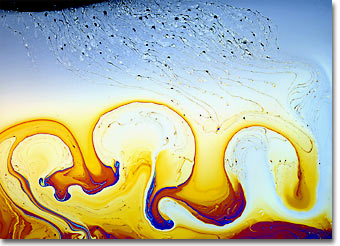Karl E. Deckart
Soap Bubble Gallery: Image Three
German photographer and artist Karl E. Deckart is known for his thorough, precise, and beautiful work both in photography through the microscope and with macro camera systems. This gallery of interference photographs made with soap films is a testament to both Deckart's skill as a photographer and his understanding of the physical phenomena that surround our everyday lives. Presented below is soap bubble image number three in small format. Click on the image to download a larger version.

|
Macrophotography of thin soap films freely suspended on a 4 x 4-inch wire frame was conducted with a Linhof large-format bellows camera system utilizing 4 x 5-inch sheet film and imaged using an apo-macro Nikon large format Nikkor-AM ED 210 mm f-5.6 lens. To prepare the soap film, equal parts of water, glycerin, and dishwasher detergent are thoroughly mixed in a container until a solution containing evenly sized micelles is achieved. A freestanding film is formed by dipping the wire frame into the solution and withdrawing carefully to maintain an even film thickness and avoid disruption of material flow across the frame rails. After suspension, the film was illuminated by a reflected light source positioned a few degrees from the camera system. The light was passed through a diffusion screen to avoid bright spots and provide an even illumination across the field. No polarizers were employed in photomacrography of soap thin films. Image ©1999 by Karl E. Deckart. All rights reserved. |
Tiled bathrooms and self-draining tubs were a part of life for many of the aristocratic ancient Greeks. Even their gymnasiums featured hot and cold showering facilities, although a quick douse of cold water over the head was considered the masculine bathing routine. Hippocrates, the "father of medicine" strongly advocated bathing, and ancient Greeks preferred sponges, metal scrapers, and oils over soaps that were available during the period, which were generally made from goat fat and ashes. In the seventeenth and early eighteenth centuries, water was considered by many to have mystical powers that could not be taken lightly. During that time, baths were not encouraged and were undertaken only with the advice of a physician, for fear that disaster might strike. By the First World War, the utility of soap as a cleaning agent for wounds and injuries was realized and large-scale manufacturing processes began to be considered.
BACK TO THE SOAP BUBBLE GALLERY
